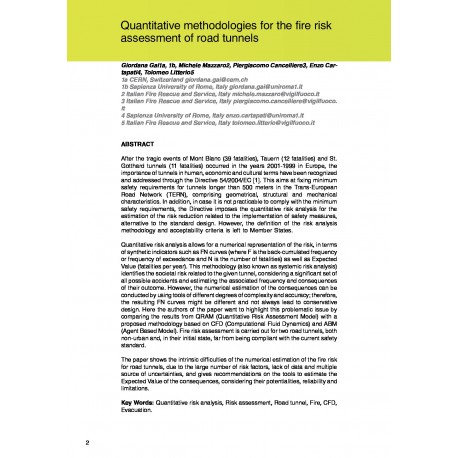Cart
0
0
No document
0,00 €
Total
Document successfully added to your shopping cart
Quantity
Total
There are 0 items in your cart.
There is 1 item in your cart.
Total documents
Total shipping
To be determined
Total
Search & filter
Search for a publication
Search & filter
Quantitative methodologies for the fire risk assessment of road tunnels
520_quantitative_methodologies_f
G. Gai / M. Mazzaro / P. Cancelliere / E. Cartapati / T. Litterio
After the tragic events of Mont Blanc (39 fatalities), Tauern (12 fatalities) and St. Gotthard tunnels (11 fatalities) occurred in the years 2001-1999 in Europe, the importance of tunnels in human, economic and cultural terms have been recognized and addressed through the Directive 54/2004/EC [1]. This aims at fixing minimum safety requirements for tunnels longer than 500 meters in the Trans-European Road Network (TERN), comprising geometrical, structural and mechanical characteristics. In addition, in case it is not practicable to comply with the minimum safety requirements, the Directive imposes the quantitative risk analysis for the estimation of the risk reduction related to the implementation of safety measures, alternative to the standard design. However, the definition of the risk analysis methodology and acceptability criteria is left to Member States. Quantitative risk analysis allows for a numerical representation of the risk, in terms of synthetic indicators such as FN curves (where F is the back-cumulated frequency or frequency of exceedance and N is the number of fatalities) as well as Expected Value (fatalities per year). This methodology (also known as systemic risk analysis) identifies the societal risk related to the given tunnel, considering a significant set of all possible accidents and estimating the associated frequency and consequences of their outcome. However, the numerical estimation of the consequences can be conducted by using tools of different degrees of complexity and accuracy; therefore, the resulting FN curves might be different and not always lead to conservative design. Here the authors of the paper want to highlight this problematic issue by comparing the results from QRAM (Quantitative Risk Assessment Model) with a proposed methodology based on CFD (Computational Fluid Dynamics) and ABM (Agent Based Model). Fire risk assessment is carried out for two road tunnels, both non-urban and, in their initial state, far from being compliant with the current safety standard. The paper shows the intrinsic difficulties of the numerical estimation of the fire risk for road tunnels, due to the large number of risk factors, lack of data and multiple source of uncertainties, and gives recommendations on the tools to estimate the Expected Value of the consequences, considering their potentialities, reliability and limitations. Quantitative risk analysis, Risk assessment, Road tunnel, Fire, CFD, Evacuation.




